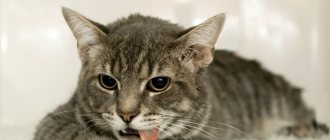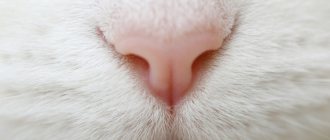Skin diseases are a common occurrence in domestic and farm animals. Pathologies manifest themselves in different ways: hair loss due to attack by parasites, problems with the epidermis and internal disorders. The causes of these symptoms need to be accurately determined. The veterinarian will not only identify the disease, but also prescribe the correct treatment. Some skin diseases can be dangerous to your pet's health.
Acne
Acne can appear due to improper care of your pet, severe stress and emotional distress. Acne can develop into pustules and ulcers, which cause severe pain for your pet and sometimes lead to inflammation.
A complication of acne is folliculitis. It is a swelling around the hair, usually with liquid contents. When touched, the pet experiences pain.
Self-medication and squeezing pimples are not recommended. You can treat rashes with tar soap or shampoo.
Preventive methods
If the kitten's skin is covered with sores and the affected area is gradually expanding, you need to make an appointment with a veterinarian as soon as possible and undergo a comprehensive examination, since the causes of the rash can be varied - from scabs to endocrine disorders.
As a preventive measure, you should monitor your pet’s hygiene, get standard vaccinations according to plan, and establish a nutritional and drinking regime. If a cat is prone to allergies, it is important to identify and eliminate the irritating factor, otherwise drug therapy will not bring results. You should not self-medicate. Sometimes the improvised drugs used do bring relief, but not for long, since eliminating the symptoms does not affect the root cause of their occurrence. Only a properly selected comprehensive therapy regimen will help cure your pet from skin problems and prevent complications.
Fungal otitis media
The disease is an inflammation of the external auditory canal. The development of fungal otitis occurs due to a weakened immune system. The pet shakes its head and scratches its ear.
The ears turn red quickly and strongly. When examining the ear with an otoscope, severe inflammation of the skin and many fungal deposits are observed.
Every day you need to clean the ear of accumulated secretions with napkins and cotton swabs. Afterwards you need to treat them with alcohol-based antiseptics.
Causes of scabies
The causative agents of pathology in pets are microscopic mites, invisible to the naked eye. There are several varieties of such mites:
- Notoedres cati provokes the development of notoedrosis - head scabies, which primarily affects the head and ears of the cat, and subsequently covers the entire skin.
- Sarcoptes canis causes sarcoptic mange, a disease accompanied by severe itching.
- Otodectes cynotis - a mite that lives in a humid, warm environment, parasitizes the ears, causes otodecosis
All types of scabies are contagious, and you can catch the disease from sick relatives or other animals. Contact of pests on your pet's skin causes them to actively reproduce and spread. Female mites form scabies burrows in the skin and leave clutches of eggs. An adult female can lay up to 50-60 eggs during her life cycle. After a few days, larvae appear and quickly turn into young individuals. The high rate of parasite reproduction can lead to various complications. Timely treatment will help avoid this.
Ear mites
Ear mites appear as a result of improper care. Symptoms: scratching, foul odor from the ears, dark gray discharge, redness of the skin of the ears, fever.
Treatment can begin after visiting a veterinarian. Various aerosols (based on Dermatosol or Tsiodrin), drops (Bars, Tsipam, Amitrazine) and ointments (Nicochloran, Phenothiazine) are used. Dark discharge should be removed with a soft cotton cloth or cotton wool.
Psychogenic alopecia
Due to thorough and prolonged licking, cats may develop bald spots. This behavior means that the pet is stressed. Sometimes baldness occurs due to allergies and fungal diseases.
First you need to check your pet for parasites and make sure there is no hypersensitivity to external irritants.
Allergic reaction
Allergy to food
Allergy is an inappropriate reaction of the body to an irritant. Atopic dermatitis is an innate predisposition to the influence of external irritants - pollen from flowering plants or the odors of tobacco smoke, perfume, and household chemicals. The cat develops a cough, runny nose, watery eyes, and itchy skin. When your pet scratches its skin, bacteria, as well as fungi, enter the wounds from the air or fur and multiply. The itching intensifies, the cat itches, ichor secretes, dries out, and crusts form.
The mechanism of development of contact dermatitis is the same as atopic dermatitis, only this pathology is acquired. If a cat was attacked by fleas, and the owner washed the windows with a household chemical, then the cat’s body would remember this smell. The fleas were driven out. The windows were washed again and the cat developed an allergy to the chemical.
Contact dermatitis develops due to the flea collar and the smell of the litter tray. Another type is an allergy to food components. Some component - for example, chicken or soy proteins, gluten, milk, chicken eggs - cause irritation.
As the allergen is consumed over a period of several months, its concentration reaches a threshold value and a skin reaction develops in the form of dermatitis. First, the crusts cover the head and neck; in advanced situations, they can spread to the back.
Treatment consists of interrupting contact with the irritant and using external and internal anti-inflammatory, antipruritic, and antihistamine drugs. In all cases, they switch to a hypoallergenic factory-made feed mixture.
Be sure to read:
A cat's hair is falling out: reasons, what to do during shedding, treatment of baldness, approved medications
Prevention consists of regular control of ectoparasites, as well as the use of professional food of at least premium class.
Adherents of natural nutrition should learn how to create a diet and stop feeding the animal food from the table. Atopic dermatitis is incurable. You should purchase kittens from trusted breeders, and if a disease is diagnosed, insist on excluding the parents from breeding.
Lice and fleas
Lice and fleas are small insects that feed on blood and the top layer of skin. If the case is advanced, it is impossible not to notice them on the pet. Favorite localization is around the tail and head.
At an early stage, an accumulation of a black substance, a waste product of fleas, is noticeable. Also, the pet experiences itching, hair loss, redness of the skin, and the formation of wounds.
Lice are eliminated using a special shampoo. Fleas are removed by treating things with which the pet comes into contact with anti-flea agents, carriers, bedding, and all carpets in the house.
Allergies
Allergies are usually caused by parasites. Symptoms: baldness in certain areas, itching, spots of different colors. The allergy will go away after eliminating the fleas after 5-6 weeks.
Also, allergies can be due to external irritants and food. Treatment in this case becomes more complicated because identifying the allergen is not easy. Shampoos with hydrocortisone work well as local antiallergic agents.
They give an immediate but short-term effect. Hydrocortisone ointments are used when pets have itching. They are applied to small areas that are inaccessible for licking.
Treatment of skin diseases in cats
Before visiting the hospital, you should prepare to answer questions about your mustachioed friend's condition. The doctor will definitely ask when the ulcers or scabs appeared and ask about diet and seasonal diseases. Having received complete information, the doctor will prescribe special tests and tests:
- biopsy;
- blood analysis;
- scrapings or smears;
- ultraviolet examination.
After laboratory tests, it will not be difficult to understand what caused the cat’s sores throughout the body. Often, a domestic cat is switched to a special diet containing mainly hypoallergenic foods. Vitamin and mineral complexes help restore the immune system. A course of antibiotics is most often accompanied by the use of probiotics to strengthen a weak body.
Sometimes medications can worsen a pet's condition. New symptoms or wounds begin to appear - this is an allergy to medications. In this case, the drugs are discontinued, and new medications are introduced with caution instead. The pet should be constantly monitored so as not to miss any unpleasant responses. If the cat’s condition has not worsened, then the course of therapy should be continued.
Most pet owners try to get rid of severe itching as quickly as possible. Indeed, if you eliminate this symptom, your pet will scratch the skin less and it will begin to heal. If scabs appear on the neck or head, a special collar is put on the animal. Eliminating itching without background therapy cannot be called the correct treatment, because it does not stop the root cause.
Buying medications on your own is strictly contraindicated, because this can lead to deterioration of health. Proper treatment promotes a quick recovery, and regular checks of the cat’s fur will be a good preventative measure against the spread of skin pathologies.
Tail gland hyperplasia
If the tail gland has increased hyperplasia, excessive accumulation of sebaceous secretion appears. It is released and envelops the hair at the point of growth, blocking its further development. Because of this, her hair falls out and areas of baldness appear.
Therapy involves monitoring the problem area. Castration can help cats.
Demodicosis
Demodicosis is an extremely dangerous disease for a pet. It can lead to the death of a cat instantly, sometimes the owner does not even have time to start treating it. Demodicosis appears due to the bite of ticks, which are numerous in the warm season.
Cats cannot take preventive and protective measures themselves, so they often become their victims. Symptoms: damage to large areas of skin, itching, redness. The worst thing is that if a pet gets sick once, then it becomes a constant source of infection. His offspring will also suffer from demodicosis.
It is important to take preventive measures - treat the skin with products that kill ticks (Bars, Harts). It is also worth using anti-inflammatory drugs (Dexafort, Laurabolin 50) and anti-itch drugs (Stop-itch).
The danger of skin pathologies for humans
Despite the fact that such diseases are an unpleasant phenomenon, most of them are not transmitted to people. Timely and correct prescription of medications makes them not dangerous for their owners.
Infection with different types of lichen and allergic reactions from blood-sucking bites require the use of medications not only for the animal, but also for the owner. They do not pose a threat to life, but the spread of scabs and ulcers throughout the body of a person or pet is not a very pleasant phenomenon, and it needs prompt treatment.
Eczema
Eczema is an unpredictable disease.
Appears due to many factors, including:
- Severe skin contamination with parasites, dirt, bacteria;
- Improper wearing of collars and synthetic clothing for cats;
- Complication of any disease (pathology of the nervous system, kidney disease, stomach and liver).
The main symptom is a weeping surface of the skin. Scratching causes knots and redness to form. The cat is rapidly losing weight, has a fever and kidney problems.
For diagnostic purposes, the veterinarian will take a skin scraping to rule out the possibility of other diseases. Afterwards he should prescribe antihistamines. You should not try to treat your cat without a doctor, as complications may develop.
Prevention
In order for the animal to be healthy, it is necessary to constantly carry out preventive measures. These include:
- Timely and regular examinations of the pet at the veterinary clinic.
- Regular treatment for parasites and helminths.
- A varied, complete and balanced diet.
- Compliance with sanitary and hygienic standards.
- Timely vaccination of the animal.
If any of the above symptoms occur, it is important to immediately seek qualified veterinary help.
Skin diseases in cats can occur as a result of an incorrect and inadequate diet or inappropriate living conditions, various injuries or damage to the skin. It is important to follow all preventive measures and regularly check the animal with a veterinarian. Some vaccines will help prevent skin lesions in animals.
Bedsores
The disease is often observed in cats in old age or after suffering an injury. Bedsores are areas on the skin that rot and die over time. If the pet is in a lying position for a long time, the disease may manifest itself.
Symptoms: pain when touched, decreased temperature of the dying area, ulcers, color change. It is worth taking preventive measures - periodically turning the cat over after operations, prohibiting sitting on the damaged paw for a long time. Therapy consists of treating wounds, dressings, and removing dead tissue.
Each disease can progress, which leads to the process of virus reproduction. Because of this, the pet suffers, he has problems with sleep and appetite, he becomes less sociable and cheerful.
If your cat develops irritation in the area of its face or body, you should take it to a specialist immediately. Not all cat diseases are not contagious to humans.
Some viruses and fungi can adapt to the organism that is nearby. It is highly likely that if the pet is left untreated, the owner’s immune system may weaken and spots may appear on the body.
Causes of sores throughout the body in cats
Damage to the skin is caused by sources of various types. These may be hereditary, infectious or anthropogenic (man-made) factors. The condition of the skin is affected by food changes, poor water quality, or even stress caused by moving to a new place of residence. Scabs, ulcers, and small wounds progress quickly without timely treatment. They cause the pet great discomfort and pain. The cat becomes nervous, scratching the affected areas.
Some ailments do not have obvious manifestations. It is possible to notice pathology only with a thorough examination of the animal. The most obvious is refusal to eat, apathetic state, and constant scratching. The wounds can be of different shapes and colors. They have one thing in common - this is an external manifestation of a serious internal disease.
The main factors may be:
- poor nutrition;
- genetics;
- allergies;
- bacterial and fungal infections;
- blood-sucking or intestinal parasites: ticks, fleas, worms;
- weak immune system.
This diversity means that pathology may well occur in almost any mustachioed friend. There are many specific reasons for this. A specialist in a veterinary clinic can find out the cause of the appearance of ulcers, wounds or scabs, as well as select the correct therapy.











